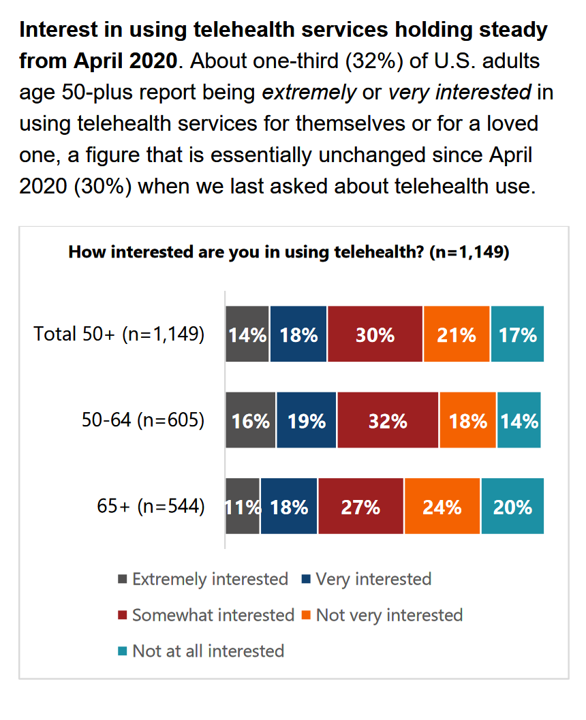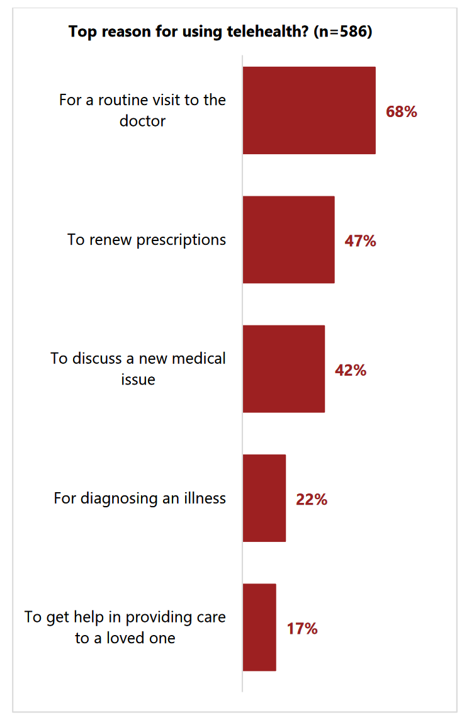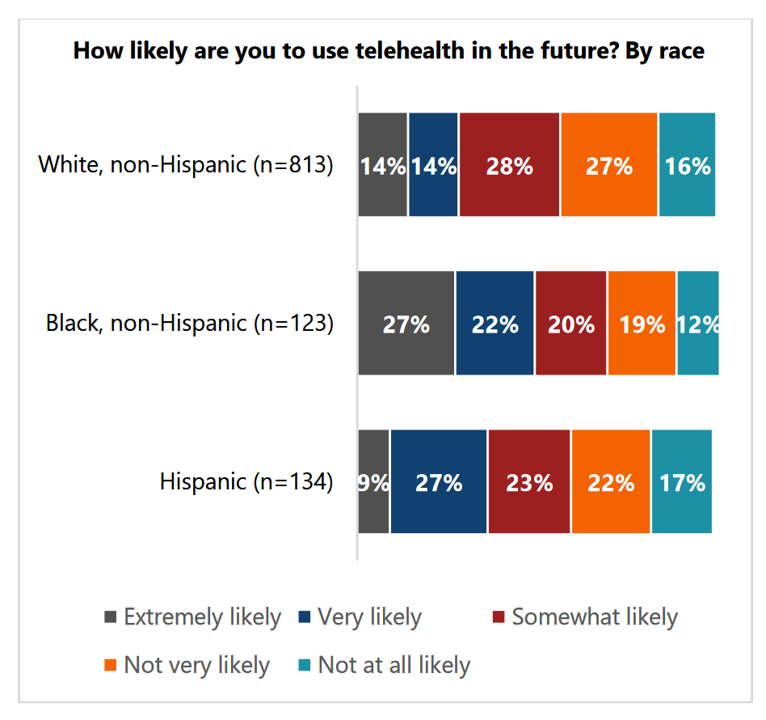[ad_1]
“Telehealth certainly appears to be here to stay,” the AARP forecasts in An Updated Look at Telehealth Use Among U.S. Adults 50-Plus from AARP.

Two years after the emergence of the COVID-19 pandemic, one-half of U.S. adults over 50 said they or someone in their family had used telehealth.
In early 2022, over half of those over 50 (the AARP core membership base) told the Association they would likely use telehealth in the future. This future expectation varies by race, the implications of which I discuss below in the Hot Points.
The study polled U.S. adults 50 and over in February and March 2022, to gauge older peoples’ views on virtual care now and in the future.
One in three people over 50 in America are most interested in telehealth, with another 30% somewhat interested. This varies from younger-olders with 35% of folks 50-64 keenest on virtual care compared with 29% most interested, shown in the first graph from the AARP’s report.
By gender, more older women are interested in using telehealth compared with men. By ethnicity/race. many more Black, non-Hispanic Americans are interested in using telehealth than White, non-Hispanic people at a difference of 45% vs. 29% (and 35% for Hispanic folks).
Adding in those “somewhat interested,” 73% of Black Americans over 50 would be interested in telehealth compared with 59% of White people and 64% of Hispanic people over 50.
By gender,50+ men were more likely (39%) than 50+ women (48%) to say they had not used telehealth in the past two years.
 Among people 50 and over, the doctor’s visit for routine care is the top reason for using virtual care, among 2 in 3 older people. That’s an important behavior change to take into future planning for primary care services targeted to older peoples’ chronic care management and remote health monitoring.
Among people 50 and over, the doctor’s visit for routine care is the top reason for using virtual care, among 2 in 3 older people. That’s an important behavior change to take into future planning for primary care services targeted to older peoples’ chronic care management and remote health monitoring.
One-half of older Americans look to telehealth to renew prescriptions, and 42% to discuss a new medical issue.
The top barrier to using telehealth for people 50+ are concerns about the quality of care not being on-par with in-person visits to doctors.
“It appears that telehealth is likely to continue to remain an important tool in the health care delivery tool kit — at least for those with computers and high-speed internet access,” the AARP report concludes with a caveat about connectivity/broadband access.
AARP conducted the study between February 24 and March 3, 2022, among 1,149 adults ages 50+ employing the NORC at the University of Chicago’s Foresight 50+ Consumer Omnibus sample.
Last month, AARP published research on older peoples’ perspectives on their state of mental health and well-being. That study found remarkable resilience among older Americans in the wake of the COVID-19 pandemic, and more recently economic challenges with inflation and the Ukrainian conflict.
Nonetheless a CVS Health survey on mental health conducted in April 2022 found that four-in-ten people age 65+ experienced mental health concerns for themselves, family or friends — a 10 percentage point increase compared with two years ago.
“While it is understandable to see a decline in mental health or emotional well-being during trying times, this is not a normal part of aging. To combat possible hesitation on the part of older adults to seek help with managing their emotional health, it is important that access to mental health treatment is easy, seamless and normalized. Ensuring mental health and emotional well-being is addressed during all medical visits is an invaluable step towards ensuring older adults receive comprehensive care,” AARP concluded.
This, too, is a call-to-action to leverage virtual care for holistic care that attends to physical, mental, emotional, and social needs among aging people.

Health Populi’s Hot Points: This third chart illustrates one of the most illuminating findings in AARP’s study into telehealth use among older Americans in early 2022.
Note the middle line in the graph quantifying the likelihood for using telehealth in the future among Black, non-Hispanic Americans who are 50+.
The net of “extremely likely” and “very likely” adds to 49% — one in two older Black people in America. Add in an addition 20% of folks who are “somewhat likely,” and you get to 70% of older Black Americans who would likely use virtual care in the future.
For White, non-Hispanic over 50s folks, the net total is 56% and for Hispanics, the net total users for telehealth in the future sums to 59%.
The exuberance among Black older people to use telehealth in the future is undeniable, and a useful statistic to keep in mind when planning for the future of Medicare coupled with breaking down access barriers to care and promoting greater health equity.
Ideas for such a call-to-action start with being design-ful and mindful about understanding peoples’ values and preferences for communication — language, tone, cultural nuances, and technology wants — such as texting versus online portals, use of personae in chatbots and avatars that sound and look like “me,” and collaborating with trusted touchpoints in local communities.
Thanks to AARP for conducting multiple studies on health and well-being that are informing our work into the future of health care, reducing health disparities, and bolstering public health for all.
[ad_2]
Source link
